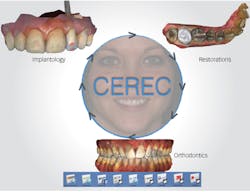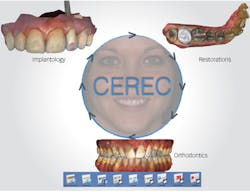Preservation of the Independent Dental Practitioner: Redefining ROI with CEREC
In the final piece on clinical competency from our series, "The Preservation of the Independent Dental Practitioner," Dr. Mike Skramstaddiscusses an alternative way to look at ROI—moving away from financial calculations toward a model that focuses on improving patient care using technology.
Technology is rapidly changing dentistry. With each new year, we see more innovative ways to deliver care to our patients. This results in some hard decision making for us as practitioners. New technology comes at a cost, both financially and in terms of implementation time. We often refer to the concept of return on investment, or ROI, to help us make these decisions.
In this article, I will propose an alternative way to look at ROI. I think it is time to redefine ROI, moving away from financial calculations toward a more patient-centric model through which we can evaluate how we treat our patients with technology to make us more successful both clinically and financially. We also have to address certain competencies to keep our practices viable: What procedures do our patients want, and how do they want them to be delivered? In order to successfully preserve the independent dental office, it is time for a new outlook on patient care and, more importantly, using technology to deliver it.
When I purchased CEREC 12 years ago, I was a younger dentist, and I was concentrating on the financial decision: Would I be able to afford it? Was it really just replacing my lab fees? Would it place unneeded financial stress on my practice? All of these questions are normal when making a decision about whether to invest in an expensive piece of technology. What I did not know then-and what I do know now-is that there is much more to making such a decision. Of course, these questions need to be asked, but you also have to ask yourself five other important questions:
1. How will this improve the patient's overall experience?
2. How will this improve my overall ability to provide predictable, high-quality dentistry?
3. Will this technology allow me to provide procedures that I was not doing before?
4. Will this technology allow me to enjoy dentistry more?
5. How will all of the questions above help me to grow my practice?
Sirona Dental Systems helped redefine "ROI" in 2015: Restorations, Orthodontics, and Implantology. This was an important step in moving away from the financial model of ROI and moving toward concentrating on what we can do with technology to improve predictability, with the patient's experience at the center of it all (figure 1).
Restorations: For the last 30 years, single-visit restorations have been the cornerstone of CEREC. The ability to make crowns, inlays, onlays, bridges, or veneers in one appointment will always be the daily measure of your success with the technology. This aspect of ROI is critical to the patient-centric model. The ability to fabricate a quality restoration in one visit has been the single biggest source of my practice growth, both financially and clinically. I never imagined the impact that this would have on my patients' overall experience in the office. The patient satisfaction it created generated a level of internal referrals we had never seen in the past.
The biggest impact on my life was the overall control I had over the final clinical product. The quantity of material choices available makes it easy to control the final shape and contour of restorations and achieve the longest lasting results.
Orthodontics: Sirona's newest offering is the Orthodontic software. Using the Omnicam, we have the ability to take accurate full-arch guided scans and send them to many orthodontic partners for aligners, appliances, 3-D printers, or planning software. Among these partners are Invisalign, ClearCorrect, SICAT, Dolphin 3D, and a large network of orthodontic laboratories.
If you're a general dentist or specialist, having CEREC as the digital hub of everything you do is a huge benefit. Not only is there complete integration, but by embracing the digital workflow, there's also an increase in efficiency. The guided scanning makes it easy to delegate the scan to assistants and gives the doctor the ability to evaluate the entire scan before sending it. Also, there is no need to keep physical models in the office. You have the ability to print the digital model through multiple partners (with or without an Orthodontic Base) at any time.
Implantology: Perhaps the biggest impact in the new ROI is Implantology. Sirona has been a leader in creating simple, integrated solutions from planning to execution. We can now do the following in our offices:
• Take a 3-D cone-beam scan of the edentulous area.
• Take an intraoral scan with the Omnicam to record all of the teeth and soft tissues. We can also virtually plan the final crown to achieve true prosthetic-driven implant planning.
• See full integration of the 3-D scan, the final virtual crown, and the surface data from the Omnicam.
• Virtually plan the proper implant placement based on the final desired prosthetics.
• Mill a surgical guide with an in-office milling machine in approximately 30 minutes.
• Perform fully guided implant surgery.
• Create a custom screw-retained provisional or custom healing cap-all digitally.
• Create a final screw- or cement-retained hybrid restoration after appropriate healing.
This total integration has created a way to treat the implant patient 100% digitally. You have the ability to control every aspect of surgery, the provisional and final restorations, and the cost. The financial aspect of digital implantology is at the core of the patient-centric model. In a typical case involving planning an implant, milling a guide, and placing the implant and final restoration, a dentist's total expense (including implant) is going to be less than $500, with total chairtime under two hours. What this has allowed me to do in my office is control cost. Knowing what your cost and chairtime are allows better and more concise treatment planning. Not only do I have the ability to lower the cost of my implant treatment and make it more affordable for the patient, but I can do so with increased profit and better control. By following this model, our office has increased our implant numbers by more than 50% per year for the last two years.
When looking at integration of CEREC or any other technology into your office, you must, of course, ask yourself (or your accountant) the necessary financial questions, do your due diligence, and be responsible. However, do not forget to ask yourself the other questions listed above. In my opinion, they might even be more important. The two keys to successfully implementing technology are knowing what it can do for your patients and knowing what it can do for you. If you enjoy dentistry more because of the technology you implement, those emotions are infectious. Your staff and patients will sense your enthusiasm, and it will make the entire office a happier, more productive environment. Better patient experiences create referrals and ultimately more financial success. That is the true ROI of technology.
PREVIOUS ARTICLES FROM THIS SERIES:
Practicing in the 'new normal'
Increased clinical competency through continuing education
Adopting a higher level of operational competency to become a better businessperson
Mike Skramstad, DDS, is a graduate of the University of Minnesota School of Dentistry and maintains a restorative practice in Orono, Minnesota. He is a certified advanced CEREC trainer, an alpha/beta tester for Sirona Dental Systems, and a resident faculty member for both Spear Education and CERECDoctors.com. Dr. Skramstad has published numerous articles on materials and CAD/CAM and has lectured internationally on implantology and digital dentistry. He has been married to his wife, Jen, for 13 years and has three children.

